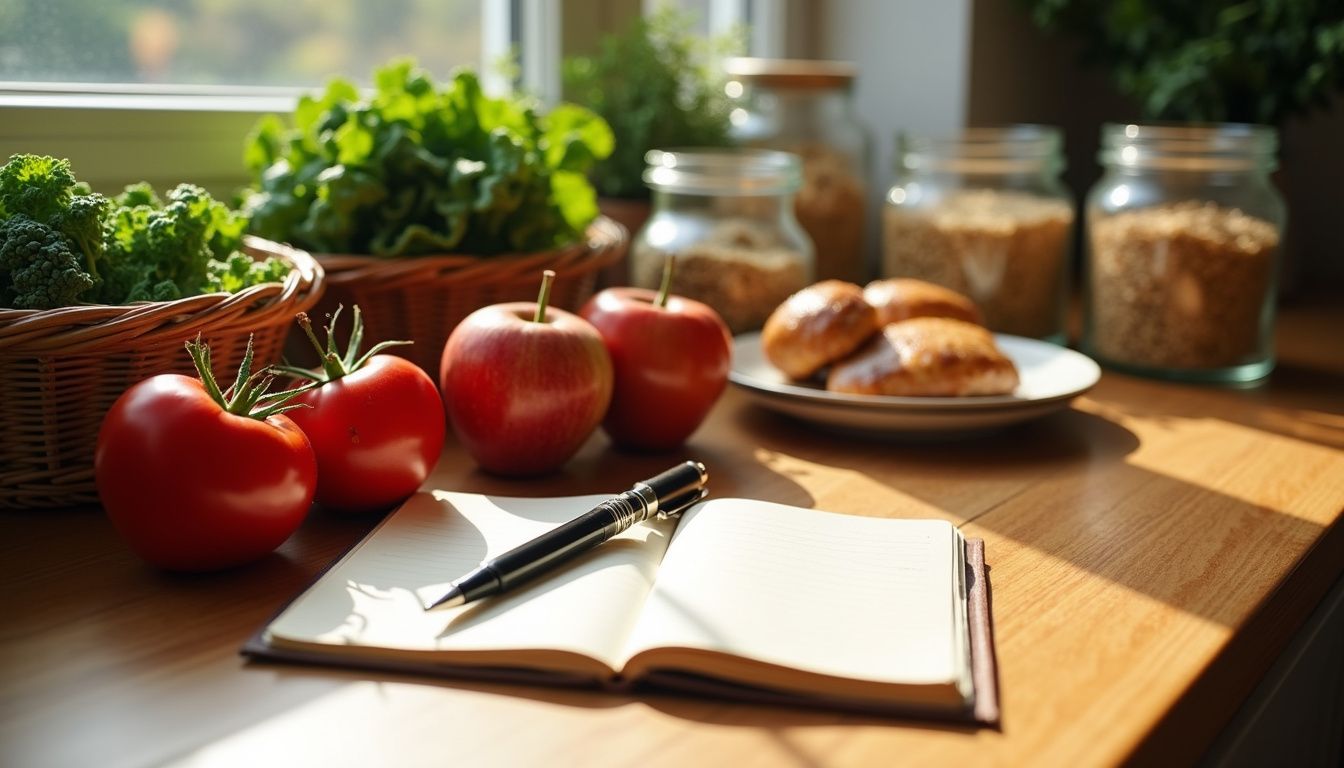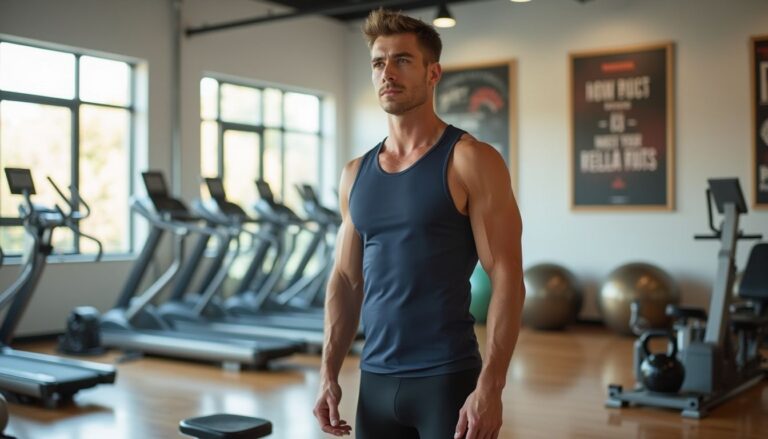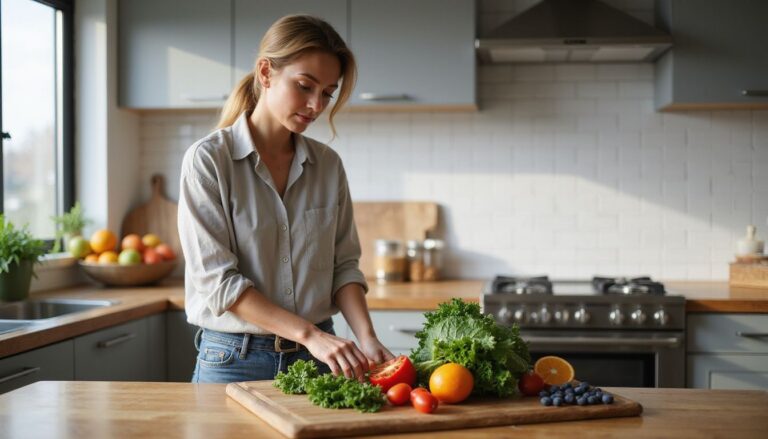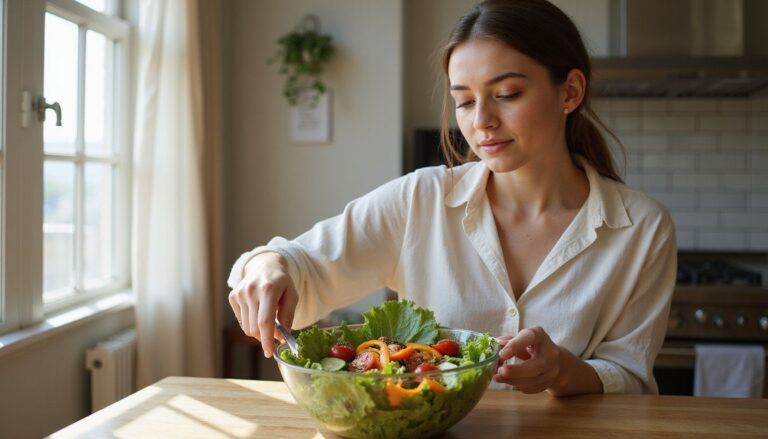Effective Simple Meal Plan For Weight Loss: Your Guide To Shedding Pounds Easily
Our Nutrition Assistant AI Suite will transform your body. You will lose fat, get toned, and build muscle. Gain confidence and optimal health.
If starting a weight loss journey feels confusing, you are not alone. A simple weight loss meal plan cuts through noise and helps you build steady habits that save time and money.
This guide shows how a structured plan supports calorie control and balanced nutrition using easy grocery items. You will learn clear steps that fit a busy life and help you lose weight without guesswork.
Keep reading, you will find practical tips that work in the real world.
Key Takeaways
- Following a structured simple meal plan with about 1,200 to 1,500 calories per day can support a steady loss of one to two pounds per week for many adults (Department of Health and Human Services).
- Meals built from lean proteins, whole grains, fruits, vegetables, and healthy fats improve fullness and nutrition while keeping calories in check.
- Consistent daily planning is linked to better long-term success than irregular eating patterns (2020–2025 Dietary Guidelines for Americans).
- High-fiber foods such as oats, beans, and leafy greens support digestion and help control hunger between meals, according to USDA guidance.
- Replacing sugary drinks with water is a simple way to lower daily calories during weight loss efforts (Harvard Health Publishing, 2021).
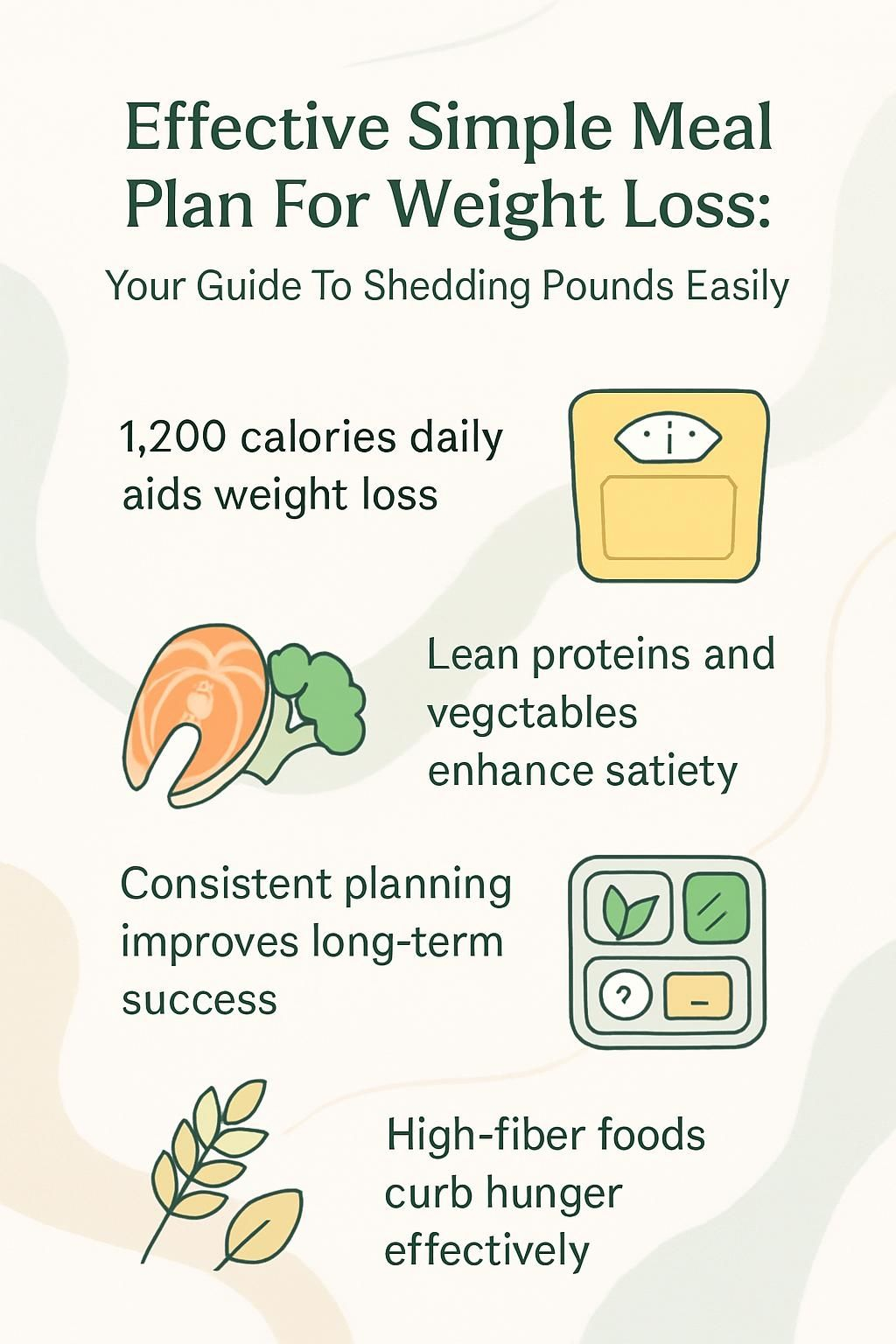
Why Simple Meal Plans Help You Lose Weight
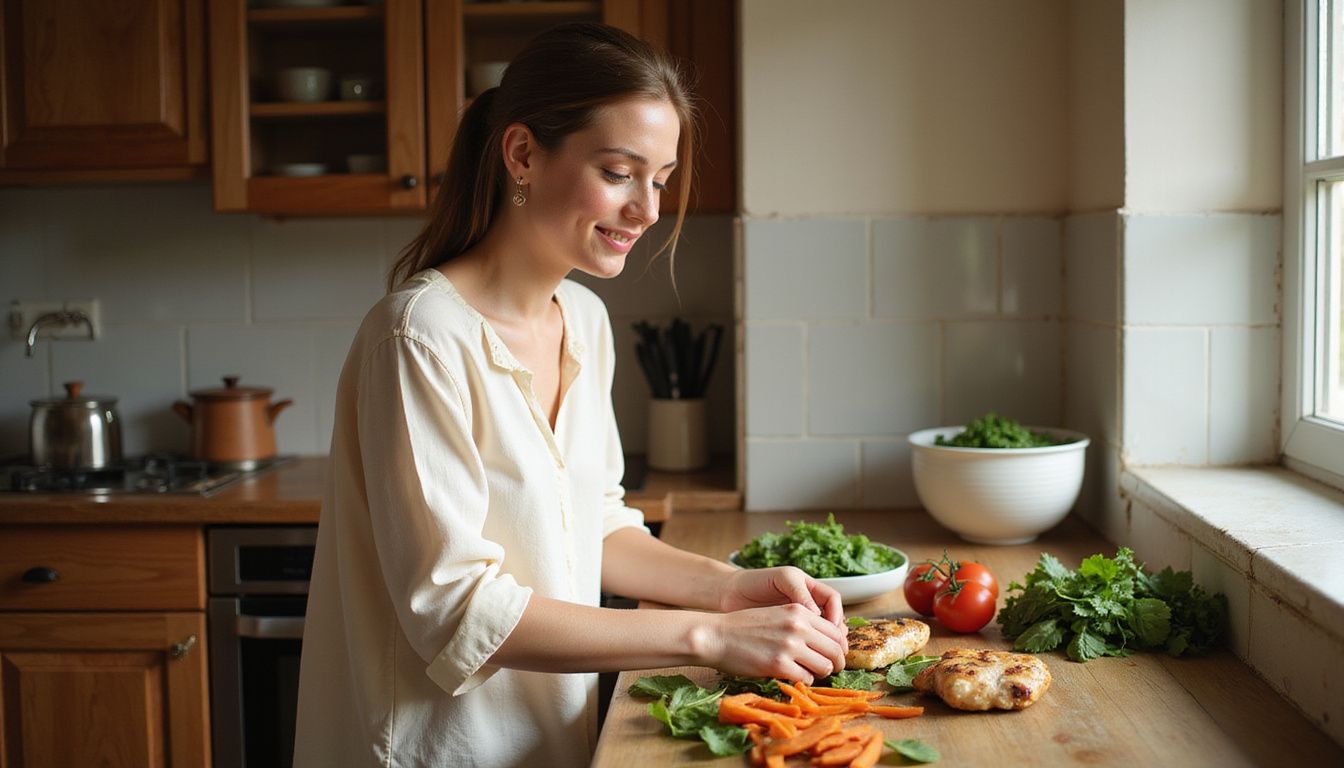
A simple meal plan lowers stress and reduces food decisions each day. Less friction means more follow-through and better results over time.
How Does Consistency Affect Weight Loss?
Consistency turns healthy choices into habits. Regular planning and home cooking help you choose better foods and avoid last-minute takeout.
Government guidance notes that a diet rich in vegetables, fruit, and lean protein supports steady fat loss. People who stick to their plan most days are more likely to reach long-term goals.
Pair your meals with regular physical activity. Repeat helpful routines like prepping a grocery list or batch cooking on the weekend. Short lapses can slow progress, so aim for simple wins each day.
Consistency is what transforms average into excellence.
Why Is Calorie Control Important for Losing Weight?
Calorie control creates a calorie deficit, which means you eat fewer calories than your body burns. This is the basic path to weight loss.
A structured diet meal plan, such as a simple 7-day plan near 1,200 calories for smaller adults, can keep you on track. Cutting 500 to 750 calories per day often leads to a loss of about one to two pounds each week.
Portion needs vary by age, sex, health conditions like diabetes or high blood pressure, and activity level. Choose lower calorie meals built from whole grains, lean proteins, and produce to meet nutrition needs while reducing total calories.
Consider medical advice if you use a low-calorie plan. The Dietary Guidelines for Americans recommend balanced choices that create healthy habits you can maintain.
What Are the Benefits of Balanced Nutrition?
Balanced nutrition helps you lose weight while keeping energy steady. You get key nutrients from whole grains, lean proteins, fruits, vegetables, healthy fats like olive oil, and low-fat dairy.
Meals that combine protein, fiber, and healthy fats keep you full longer. Aiming for about 20 to 30 grams of protein per meal can also reduce cravings.
Produce supports heart health and immunity. Fiber supports digestion and steadier blood sugar. I swapped candy for apple slices with natural peanut butter during my own plan, and the afternoon energy dip faded within a week.
Essential Foods for an Effective Weight Loss Meal Plan
Choosing the right foods makes your meal plan easier to follow and more satisfying. These basics cover protein, carbs, fats, and produce.
What Are Lean Proteins and Why Are They Important?
Lean proteins include grilled chicken, turkey, tofu, white fish, and cottage cheese. They deliver protein with fewer calories and less saturated fat.
Aim for roughly 20 to 30 grams of protein at each meal. Protein boosts fullness and helps maintain muscle as you lose weight. Your body also uses more energy to digest protein than carbs or fat, which slightly increases calorie burn.
Protein-rich meals support satiety and help you stick with your plan. Next, see how whole grains and complex carbs bring steady energy.
How Do Whole Grains and Complex Carbs Support Weight Loss?
Whole grains and complex carbs provide slow, steady fuel. Choose brown rice, quinoa, oats, and 100% whole-wheat bread instead of refined grains like white bread or regular pasta.
Fiber in whole grains slows digestion and smooths blood sugar spikes. You feel full on fewer calories, which helps you maintain your calorie target. A bowl of oats or a whole-wheat English muffin beats sugary cereal for morning energy.
Research links complex carbs to better digestion and fewer cravings for added sugars. Try canned black beans, sweet potatoes, corn, or chickpeas for budget-friendly, fiber-rich options.
Which Healthy Fats Should You Include?
Choose fats from almonds, walnuts, chia seeds, and flaxseeds. Use small amounts of olive or avocado oil for cooking or dressing.
These fats support heart health and help you absorb vitamins from vegetables and fruits. Skip fried foods and limit high-fat dairy to cut saturated fat and keep calories under control.
Why Are Fruits and Vegetables Crucial?
Fruits and vegetables are low in calories and high in nutrients. Examples include apples, oranges, bananas, berries, spinach, carrots, broccoli, green beans, and bell peppers.
Produce adds volume to your plate, which increases fullness. People who eat more produce often take in fewer total calories. Filling half your plate with vegetables at lunch and dinner can help you keep weight off without losing flavor.
These foods also supply vitamins and antioxidants. One orange can provide most of your daily vitamin C.
A 7-Day Simple Meal Plan for Weight Loss
This 7-day plan offers simple, balanced meals. You will see a mix of berries, lean proteins, whole grains, and vegetables every day.
Day 1:
Day 1 uses easy meals that do not break your budget. Lean proteins, whole grains, and produce lead the way.
- Start your morning with plain Greek yogurt topped with fresh berries and a sprinkle of cinnamon.
- Add one slice of whole-grain toast and a boiled egg for steady energy and extra protein.
- For lunch, build a large salad with spinach or lettuce, tomato, cucumber, and onion. Top with grilled chicken and one tablespoon of vinaigrette.
- Add hummus with carrot sticks or sliced bell pepper for a crunchy, nutrient-rich side.
- Have an apple or orange after lunch for fiber and natural sweetness.
- Dinner: baked salmon seasoned with garlic and black pepper. Add steamed broccoli and half a cup of cooked brown rice.
- Drink water through the day instead of sugary drinks. Aim for at least eight cups.
- Batch cook chicken or fish to speed up weekday meals.
- Avoid processed snacks that pack extra salt and added sugars.
- If you want dessert, keep it small. A square of dark chocolate can satisfy a sweet tooth.
Each step focuses on nutrient-dense foods with smart prep. Simple routines drive consistency and long-term success.
What Should You Eat for Breakfast on Day 1?
Cook oatmeal and top it with sliced banana and a dash of cinnamon. Add a hard-boiled egg for protein.
Oatmeal is rich in fiber, which keeps you full longer. Bananas add potassium and natural sweetness. The egg adds around 6 grams of protein to support muscle while you increase physical activity. These basic items are affordable and easy to find.
What Is a Healthy Lunch for Day 1?
Make a turkey sandwich on whole-grain bread. Add lettuce or spinach, tomato, cucumber, and mustard for flavor without extra calories.
You get protein, fiber, and vitamins in one quick meal. It fits a tight schedule and supports weight loss goals.
What Is a Balanced Dinner for Day 1?
Choose grilled chicken with steamed broccoli and brown rice. Season the chicken with herbs or a light mustard sauce.
This plate offers lean protein, fiber, and complex carbs. Expect about 300 to 350 calories per serving depending on portion sizes. It is simple, filling, and budget-friendly.
Day 2:
Day 2 highlights nutrient-dense meals that help you control calories and stay full.
- Blend a no-cook smoothie with berries, banana, strained yogurt, and milk for a fast breakfast.
- Or try whole-grain toast with eggs and fresh cilantro for a savory start.
- Lunch: hot vegetable soup with a veggie burger on whole-grain bread for extra fiber.
- Boost flavor with mustard or herbs instead of high-calorie toppings.
- Dinner: barbecue-style cutlets with sautéed spinach and roasted sweet potato.
- Batch cook dinner components to create easy leftovers for the next day.
- If you eat vegetarian, add soybeans or other legumes for complete protein.
- Snack on orange slices or a small handful of nuts between meals for steady energy.
- Keep your grocery budget in check by buying seasonal produce like pears or berries.
- Cook at home more often than eating out. Home cooking improves portion control and ingredient quality based on current evidence.
What Should You Eat for Breakfast on Day 2?
Greek yogurt with berries makes a fast and filling breakfast. The protein supports fullness and the berries add antioxidants.
Add an apple for extra fiber without many calories. Buying plain yogurt and seasonal fruit keeps costs low while supporting your goals.
What Is a Healthy Lunch for Day 2?
Lentil soup is an excellent lunch choice. Lentils offer plant protein and fiber that keep you full longer. One cup of cooked lentils provides about 18 grams of protein and 15 grams of fiber.
Cook with staples like onions, carrots, tomatoes, garlic, and spices. Add whole-grain toast or a small side salad topped with nuts if you want more crunch.
What Is a Balanced Dinner for Day 2?
Serve stir-fried tofu with mixed vegetables and quinoa. Tofu supplies plant protein. Quinoa is a whole grain rich in fiber and minerals.
Use broccoli, bell peppers, and carrots for color and vitamins. Steam vegetables first, then stir-fry briefly for texture. A serving can provide around 25 grams of protein and 7 or more grams of fiber.
…
[1] U.S. Department of Agriculture FoodData Central: Nutrition Facts for Tofu (100g) – Protein: ~8g; Quinoa (185g cooked): Fiber: ~5g
Day 3:
Day 3 keeps meals simple and filling. You will use easy ingredients to stay on track.
- Breakfast: egg whites with spinach in a nonstick pan for lower fat and more vitamins.
- Peel an orange for fiber and vitamin C.
- Lunch: chicken salad made with shredded skinless chicken, grapes, and chopped almonds on crisp lettuce.
- Use mustard as a light dressing instead of creamy sauces.
- Snack: Greek yogurt with a small handful of nuts for protein and healthy fat.
- Dinner: black beans with chili powder and salsa for fiber and plant protein.
- Add roasted vegetables like broccoli or zucchini for more volume and nutrients.
- Drink water or unsweetened herbal tea instead of juice or soda.
- Grill extra chicken for leftovers later in the week.
- Track servings in a food journal to see patterns that support your goals.
I used these ideas after long days of school pickup. More fruit and ready protein left me satisfied and away from chips.
What Should You Eat for Breakfast on Day 3?
Blend a spinach banana smoothie with almond milk. Add a small handful of almonds on the side for protein and healthy fat.
This combo provides fiber, vitamins, and lasting energy. It takes about five minutes to prepare and travels well.
What Is a Healthy Lunch for Day 3?
Tuna salad offers lean protein with few calories. Mix in chopped tomatoes, cucumbers, and leafy greens for fiber and crunch.
Add lemon juice or a light olive oil dressing for flavor. It is quick, affordable, and keeps you full.
What Is a Balanced Dinner for Day 3?
Bake salmon with sweet potatoes and green beans. Salmon provides healthy fats and protein for fullness. Sweet potatoes deliver complex carbs and vitamin A.
Green beans add fiber and vitamin C. I often roast the sweet potato while the fish cooks, which saves time on busy nights. A Mediterranean-style approach like this supports steady, nutritious eating.
Day 4:
Day 4 sticks to about 1,200 calories for smaller adults. Meals are quick, colorful, and high in protein and fiber.
- Breakfast: Greek yogurt with fresh berries for protein and antioxidants.
- Snack: an orange for vitamin C at low calories.
- Lunch: tomato soup with a roast beef sandwich on whole-grain bread.
- Add a little feta to a salad or sandwich for flavor and calcium.
- Snack: a small handful of mixed nuts for healthy fats and fullness.
- Dinner: poached salmon with cabbage and carrot slaw.
- Pack in colorful vegetables to increase fiber intake.
- Drink water through the day in place of sugary drinks.
- Keep recipes simple to build consistency and momentum.
Quick-prep foods like yogurt, citrus, sandwiches, nuts, and fish helped me stay on track during a busy month.
- Nutrition Reviews (2022), “Omega-3 Fatty Acids Improve Body Composition”
- Centers for Disease Control & Prevention (CDC), “Adult Obesity Facts,” 2022
- Harvard Health Publishing (2021), “Simple Ways to Cut Calories
What Should You Eat for Breakfast on Day 4?
Scrambled eggs with spinach bring protein, iron, and key vitamins like K and folate. They are quick to cook and budget-friendly.
Protein supports fullness and muscle repair if you exercise. Spinach adds nutrients with very few calories.
What Is a Healthy Lunch for Day 4?
Pack carrot sticks with hummus for crunch and a fiber boost. Add chickpea salad for extra protein and staying power.
Plant-based lunches like this are easy to prepare and travel well. Chickpeas provide about 7 grams of protein per half cup.
What Is a Balanced Dinner for Day 4?
Eat turkey meatballs with whole-wheat spaghetti. You get lean protein and fiber-rich carbs in one plate.
A typical serving offers about 25 grams of protein and 6 grams of fiber. High-protein meals help preserve muscle during weight loss.
…
^1 Harvard T.H. Chan School of Public Health: The Nutrition Source – Protein.
Day 5:
Day 5 delivers energy and variety with simple, balanced meals.
- Breakfast: Cheerios with mixed berries, slivered almonds, and a spoon of Greek yogurt.
- Lunch: mushroom quesadillas on whole-wheat tortillas with cucumber spears.
- Side: cottage cheese or Greek yogurt with clementines for calcium and protein.
- Dinner: balsamic-glazed pork tenderloin over steamed vegetables or leafy salad, about 370 calories per serving.
- Keep total close to 1,200 calories by filling half your plate with produce.
- Drink water often to manage hunger cues.
- Adjust portions based on your activity level and personal needs.
What Should You Eat for Breakfast on Day 5?
Have whole-grain toast with peanut butter and sliced banana. It delivers fiber, healthy fats, and potassium.
Pairing complex carbs with protein helps you stay full. One study found meals with fiber and healthy fat improve appetite control for several hours.
…
^1 Source: Journal of Nutrition, Health & Aging, 2022.
What Is a Healthy Lunch for Day 5?
Cook a quinoa bowl with black beans for plant-based protein and fiber. Quinoa is a complete protein, and beans add about 7 grams of protein and 8 grams of fiber per half cup.
Top with tomatoes, spinach, or bell peppers. Add an orange for vitamin C that supports immune health.
What Is a Balanced Dinner for Day 5?
Make grilled chicken fajitas with colorful peppers and onions. Use a nonstick pan to limit oil.
Serve with warm whole-wheat tortillas. The mix of protein and fiber makes a filling, flavor-packed dinner that fits your calorie target.
Day 6:
Day 6 focuses on easy meals with protein, fiber, and healthy fats. These help you feel satisfied while keeping calories reasonable.
- Breakfast: whole-grain frozen waffle with nut butter, banana slices, and cinnamon. Have one cup of fat-free milk.
- Lunch: tuna salad made with a mix of low-fat mayo and plain yogurt. Add baby carrots and a small pear.
- Dinner: spicy sausage jambalaya with brown rice and lean turkey or chicken sausage. Serve with sautéed spinach and garlic.
- Pick high-fiber foods at each meal to curb overeating.
- Swap brands or ingredients if needed. Flexibility helps you stay consistent.
- Talk with your clinician before starting a low-calorie plan if you have medical conditions.
- Include lean proteins, whole grains, fruits, vegetables, and moderate healthy fats daily.
What Should You Eat for Breakfast on Day 6?
Try cottage cheese with pineapple and one boiled egg. You get protein, calcium, and vitamin C with a small calorie load.
High-protein breakfasts can reduce later cravings. This option is quick, tasty, and supports strong bones and muscles.
What Is a Healthy Lunch for Day 6?
Make a vegetable stir-fry with tofu and brown rice. Tofu provides plant protein. Vegetables add fiber and vitamins.
Brown rice supplies whole-grain carbs for steady energy. Cook extra to save time during the week.
What Is a Balanced Dinner for Day 6?
Bake a lean white fish such as tilapia or cod. Serve with steamed broccoli and quinoa for fiber and minerals.
This meal is filling and low in calories. Lean protein supports muscle repair. Vegetables and whole grains improve fullness and heart health.
The next section covers what to eat for breakfast on Day 7.
Day 7:
Day 7 builds on earlier days so you can finish strong. Meals stay practical and simple.
- Breakfast: mixed berry smoothie with unsweetened almond milk, under 200 calories.
- Snack: a handful of walnuts for healthy fats and satiety.
- Lunch: lentil salad with cucumbers, tomatoes, and crumbled feta.
- Side: roasted vegetables like broccoli or zucchini for extra nutrients.
- Dinner: grilled chicken breast with brown rice and roasted vegetables such as carrots or bell peppers.
- Keep total around 1,200 calories if that suits your size and activity.
- Drink water all day to manage cravings and stay hydrated.
- Prep in batches to simplify weekdays.
- Use leftovers in wraps or salads.
- Choose fresh fruit as dessert to satisfy sweet cravings with fewer calories.
This day uses whole grains, lean protein, legumes, fruits, and healthy fats for sustainable results.
What Should You Eat for Breakfast on Day 7?
Blend one cup frozen mixed berries, half a banana, one cup low-fat milk or unsweetened almond milk, and a tablespoon of chia seeds. Add a small handful of walnuts on the side.
Berries deliver antioxidants. Walnuts provide healthy fats and protein for longer fullness. Prepping smoothie packs in advance can make mornings easier.
What Is a Healthy Lunch for Day 7?
Lentil salad offers protein and fiber to keep you full. Add chopped cucumbers, tomatoes, fresh herbs, and lemon juice for brightness without added calories.
A cup of cooked lentils gives about 18 grams of protein and 15 grams of fiber. Portion into containers for quick lunches on busy days.
What Is a Balanced Dinner for Day 7?
Grilled chicken pairs well with roasted vegetables and brown rice. You get lean protein, fiber-rich produce, and whole-grain carbs for steady energy.
This dinner is affordable, simple, and satisfying. Studies show that combining protein, vegetables, and whole grains helps control hunger and supports healthy weight loss.
…
[1] Harvard T.H. Chan School of Public Health: “The Nutrition Source – Protein”, 2024.
What Foods Should You Eat or Avoid for Weight Loss?
Food choices shape your results. Focus on foods that deliver nutrients and keep you full, and limit items that pack calories with little benefit.
Which Foods Help With Weight Loss?
These foods support your weight loss plan by improving fullness and nutrition.
- Whole grains like brown rice, quinoa, and oats provide steady energy and reduce blood sugar spikes. Diets rich in whole grains are linked to lower body fat.
- Lean proteins such as chicken breast, turkey, fish, tofu, and lentils build muscle and curb cravings.
- Legumes including beans, chickpeas, and lentils supply both protein and fiber that promote satiety. One cup of cooked lentils has about 18 grams of protein and 15 grams of fiber.
- Fiber-rich vegetables such as broccoli, leafy greens, carrots, peppers, and cauliflower add volume with few calories.
- Fresh fruits like apples, berries, oranges, bananas, kiwis, and pears offer vitamins and water that help hydration.
- Low-fat dairy products including plain Greek yogurt or milk provide calcium and protein with fewer calories.
- Healthy fats from avocados, almonds, walnuts, chia seeds, and olive oil give lasting energy. Keep portions small to manage calories.
Which Foods Should You Avoid to Lose Weight?
Limiting these foods makes it easier to meet your calorie goal.
- Processed snacks like chips, cookies, and pastries. They are calorie dense and low in nutrients.
- Sugary drinks such as soda, sports drinks, and sweet tea. A 12-ounce soda has about 150 calories and no key nutrients.
- Fast food items with large portions, trans fats, and high sodium that can trigger overeating.
- Refined grains like white bread and standard pasta. They offer little fiber and may leave you hungry sooner.
- High-fat dairy like full-fat cheese and cream that raise saturated fat intake.
- Fried foods that add extra calories from oil.
- High-sugar desserts and cereals that spike calories without helping your nutrient goals.
- Heavily processed frozen dinners or processed meats that often include additives and excess sodium.
I saw better appetite control after swapping soda for water at lunch. That one change made weekly progress easier.
How Can You Plan Meals Successfully?
Planning improves follow-through. A few simple steps can make healthy eating the default choice during a busy week.
Why Should You Plan Meals in Advance?
Planning ahead ensures you have balanced foods ready to go. It supports calorie control, reduces stress, and saves time.
Prepping on Sunday can cover several weekdays. Research links meal planning to better diet quality and healthier weights.
…
Reference:
[1] Journal of Nutrition Education and Behavior (2017) – “Meal Planning Is Associated With Food Variety, Diet Quality, and Body Weight Status”
How Does Batch Cooking Save Time?
Batch cooking lets you prepare multiple portions at once. Roast a tray of chicken and vegetables to use in lunches and dinners for days.
Having ready food at home lowers the chance of last-minute fast food. Leftovers can become bowls, wraps, or soups with little effort.
I make a large stir-fry once and eat it in different ways during the week. A clear grocery list keeps the process simple and budget friendly.
Why Stick to a Grocery List?
A list helps you avoid impulse buys and stay aligned with your plan. It also reduces spending because you buy only what you need.
With every ingredient on hand, cooking at home gets easier. That lowers gaps in nutrition and helps you resist less healthy snacks.
How to Add Variety to Avoid Boredom?
Rotate proteins, grains, fruits, and vegetables. Swap chicken for fish or beans. Trade brown rice for quinoa or whole-wheat pasta.
Pick seasonal produce to save money and add flavor. Try one new recipe each week using items already on your list.
How Can You Stay Consistent With Your Meal Plan?
Consistency drives results. Set targets you can keep, allow small treats, and check progress weekly.
How to Set Realistic Weight Loss Goals?
Aim to lose 5% to 10% of your starting weight over about six months. Even a 3% to 5% loss can improve blood sugar and triglycerides.
Check your BMI and talk with a clinician if you have questions. Track more than weight, like waist size and how your clothes fit. Small milestones keep motivation high.
How to Allow Flexibility for Treats?
You can include treats and still lose weight. Reduce a main dish by 10% to 15% on treat days to fit a small dessert.
Pick a square of dark chocolate or a single scoop of ice cream. Planning treats once or twice a week prevents burnout and binge eating. Research shows flexible plans improve long-term success.
How to Track Progress and Adjust Your Plan?
Weigh in weekly and note trends. Measure your waist. For many adults, over 35 inches for women or 40 inches for men signals higher risk.
Watch other health markers like blood pressure and cholesterol. If progress stalls, adjust portions or increase activity. Tracking helps you make smart changes early.
Conclusion
A simple meal plan for weight loss makes healthy eating easier. You control calories with filling meals built from lean protein, whole grains, and plenty of fruits and vegetables.
Planning ahead cuts stress and costs while building strong habits. Evidence supports consistent, flexible routines that you can keep for life. Start with this plan, tailor it to your needs, and let steady progress guide your next step.
[1] Sassos S., “The Best Meal Plan for Weight Loss,” Good Housekeeping Institute
[2] Mayo Clinic Staff, “Weight loss: Choosing a diet that’s right for you,” Mayo Clinic
Health disclaimer: This article is for education only and is not medical advice. Talk with your healthcare provider about your calorie needs, health conditions, and any diet or exercise plan.
FAQs
1. What is a simple meal plan for weight loss and how does it work?
A basic eating schedule for losing weight includes balanced meals with lean protein, whole grains, fruits, and vegetables. This approach helps control calorie intake while providing essential nutrients. Research shows that structured plans support steady fat loss when paired with regular activity.
2. How many calories should I eat each day to lose weight safely?
Most adults can aim for 1,200 to 1,500 calories per day if female or 1,500 to 1,800 calories per day if male; these ranges promote gradual fat reduction according to the Centers for Disease Control and Prevention (CDC). Individual needs may vary based on age, size, and activity level.
3. Can I include snacks in an effective meal plan for shedding pounds?
Yes; healthy snacks such as Greek yogurt or carrot sticks can help manage hunger between meals without adding excess sugar or saturated fats. Studies suggest that planned snacks improve satisfaction and reduce overeating at main meals.
4. What results can I expect from following a simple meal plan focused on weight management?
Many people report losing one to two pounds weekly by sticking to a consistent eating pattern rich in fiber and low in processed foods. In my own experience using this method alongside daily walks led me to drop ten pounds over two months while feeling more energetic throughout the day.
Summary: A straightforward food routine centered around nutrient-dense choices supports safe progress toward bodyweight goals; evidence highlights its effectiveness when combined with physical movement and mindful snacking habits.

